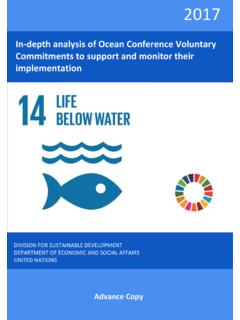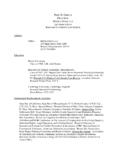Transcription of DP Operations & Risk Management Tools (CAMO-ASOG)
1 1st Brazilian conference on Dynamic Positioning DP Operations & Risk Management Tools (CAMO-ASOG) Alexander Castro LLA Marine Niter i, Brasil Matt Roberts DP DST UK DP Operations & Risk Management Tools (CAMO-ASOG) Rev E 2 Abstract Historical records show that structured operational limits criteria were first formally used in Europe with the WSOG (Well Specific Operating Guidelines) and in Brazil with the degraded status criteria. Establishment of structured operational limits criteria are very important to support incident free and efficient DP Operations . Critical Activity Mode of Operation (CAMO) is how to configure the vessel s DP system, including power generation and distribution, propulsion and position reference systems. Activity/Well Specific Operating Guidelines (ASOG/WSOG) sets out the operational, environmental and equipment performance limits considered necessary for safe DP Operations whilst carrying out a specific activity.
2 DP DST is new software that supports the ASOG/WSOG/CAMO and applies this engineered process, transforming it to a new level by actively and digitally interfacing the ASOG/WSOG/CAMO around the vessel/rig and shore side support. Keywords CAMO (Critical Activity Mode of Operation) ASOG (Activity Specific Operating Guidelines) WSOG (Activity Specific Operating Guidelines) TAM (Task Appropriate Mode) DP (Dynamic Positioning) Introduction Dynamic positioning system is the complete installation necessary to maintain the vessel s position and heading within predefined limits, consisting of the following main subsystems: power system, propulsion system and dynamic positioning control system. Although DP FMEAs shall cover the analysis of all such subsystems, they may not specify the complete configuration of the DP system. Bus ties configuration is always included, however many other important equipment and system configurations maybe omitted or not clearly defined.
3 For example: Minimum quantity of generators connected per SWB section. Maximum generators or switchboards load. With the industry growth in DP vessels, technology advances with more complex designs, along with a decline in experienced and trained operators, means that often the DP redundancy and fault tolerance is defeated by the operator by incorrect application of the operational design criteria. Establishment of structured operational limits criteria are very important to support incident free and efficient DP Operations and is now in use globally with outstanding results providing reduced DP incidents. In addition to providing structured limitations, there is a requirement to share the information/limitations to all users and invested parties. When an operational limitation occurs, the information must be communicated to all parties, by applying the successful ASOG/WSOG/CAMO in a digital/software environment, it ensures that all parties are provided with the live and current fault tolerance.
4 History In 1982 one of the first DP semi formal documents by the UK Department of Energy was issued, although limited, it highlighted the necessity of effective operational limits to be defined for DP drilling (Adamson and Abrahamsen, 2006). The use of risk Management Tools for DP Operations started with the WSOG in the late 90 s. The first issue of a WSOG was the Ocean Alliance campaign between 1997 and 1998 (Adamson and Abrahamsen, 2006). In 2004 Shell introduced the ASOG process for project vessels, but their use of the ASOG/WSOG has developed now to all DP vessels and DP MODUs. In Brazil, with the Petrobras DPPS (Dynamic Positioning Safety Program), and their proactive policy, one of the concepts introduced in 1995 was the Degraded Status Criteria for all DP drilling rigs. According to Pallaoro (2005), the Degraded Status Criteria describes the minimum equipment and system configuration necessary for normal station keeping and also the general limit values for alarms in each stage of position loss, including all kind of Operations performed by the rig.
5 Nowadays the degraded status criteria is in use with the DP drilling rig, DP production rigs and DP shuttle tankers. The ASOG/CAMO was first introduced as part of an international industry guideline by the MTS (Marine Technology Society), through the DP Operations Guidance, published in 2010. The first oil major s to introduce the WSOG as part of their internal procedures was Statoil in 2000 (Adamson and Abrahamsen, 2006). Since then, the WSOG/ASOG/CAMO has been included in several oil major s DP procedures, such as, Shell, BP and Chevron. Risk Management Tools The risk Management methods that have been increasingly used through the offshore industry are the CAMO, TAM and ASOG/WSOG. IMCA M220 establishes clear definitions on such Tools , as follows: CAMO Critical Activity Mode of Operation: sets out the most fault tolerant configuration for the DP system and associated plant and equipment. For DP Class 2/3 vessels usually defines the most robust fault tolerant configuration of the DP system ensuring that a single point failure does not exceed the vessel s identified worst case failure (IMCA M220, 2012).
6 CAMO is applied to all critical activities. CAMO is also referred as SMO (Safest Mode of Operation) in the MTS DP Operations Guidance first revision. CAMO - Critical Activity Mode of Operation M/V LLA DST This setup applies when the vessel is carrying out Operations while on DP Vessel to be set up and stabilized on DP before entering the 500m zone. Condition GREEN ADVISORY Notify Master, Chief Engineer, Client Rep, and other vessels in area NO YES Action CONTINUE NORMAL Operations INFORMATIVE / CONSULTATIVE STATUS (RISK ASSESS) Switchboard set up bus tie open 480V bus tie closed Any other set up Shaft generators Tested at 100% on field arrival or within the last 6 months Not tested at 100% on field arrival or within the last 6 months or problems found Shaft generators SG1 and SG2 online. Any other set up Auxiliary Diesel Generators DG1 and DG2 online. Any other set up Gyros All Gyros Enabled Any Gyro unavailable DP Control System Available Unavailable Fig.
7 1: CAMO Sample (Partial) TAM Task Appropriate Mode: Risk-based operating mode in which the DP vessel may be set up and operated, accepting that a single point failure could result in exceeding the vessel s identified worst case failure (IMCA M220, 2012). TAM is applied to less critical activities where position loss is found acceptable before the project/operation. ASOG Activity Specific Operating Guidelines: sets out the operational, environmental and equipment performance limits for the location and the specific activity the vessel is undertaking (IMCA M220, 2012). ASOG - Activity Specific Operating Guidelines M/V LLA DST Condition GREEN ADVISORY YELLOW RED Notify Master, Chief Engineer, Client Rep, and other vessels in area NO YES YES YES Action CONTINUE NORMAL Operations INFORMATIVE / CONSULTATIVE STATUS (RISK ASSESS) PREPARE TO ABORT Operations ABORT Operations DP Checklists (Location, Bridge and ECR) Completed Not completed or abnormalities noted Current and predicted weather conditions Within Operating limits, both intact and after worst case failure (Verify capability plots) Approaching operating limits Exceeding operational limits Prevailing weather force Not towards asset Weather changing towards asset Towards Asset DRIVE OFF or All systems operating correctly Difference in vessel position between Survey, Navigation and DP Immediately when recognized by DPO Unable to bring vessel under control DRIFT OFF Main Propulsion Load <45% Approaching 50% Any >50% Fig.
8 1: ASOG Sample (Partial) WSOG Well Specific Operating Guidelines: Same as the ASOG, for a vessel/rig undertaking drilling Operations . Developed for a specific well or drilling activity. All the risk Management Tools are presented in a tabulated format, where the columns indicate the operational DP status: Green : Normal Operations . Blue : Advisory Status. Risk asses to safely continue the operation with proper mitigation or move to yellow. An issue that has no immediate risk. Yellow : Stop the Operations in a controlled manner and commence contingency plan. Loss of redundancy or if the vessel has exceed the operational limits. Red : Emergency situation. Immediately stop the Operations . Actual Use of Risk Management Tools Recognizing the importance of the ASOG/CAMO, BP has defined it at the centre of their Upstream processes and mandated the requirement through a Close Approach and Dynamic Positioning defined practice.
9 The ASOG/CAMO implementation process has begun with the development of standard templates and following a Management of Change process roll out will be completed by 2014. The WSOG has been included in the Statoil DP drilling requirements since 2000. Shell has implemented the ASOG/CAMO since 2004 with a successful record of safe DP Operations with limited position loss. Petrobras has the Degraded Status Criteria implemented within their drilling units through the DPPS. Chevron has included in their Upstream Marine Standard that all DP vessels or units shall comply with the current version of MTS DP Operations Guidance and Appendices as a global DP operating requirement. DP Rules and Guidelines DP vessels are currently governed by rules, regulations and guidelines that include the design, operation, training and manning subjects. Rules and regulations are prescribed by: Classification Societies (Design) Nautical Institute (DPOs Training) Flag States (DPOs Training, Manning and DP vessels/units requirements and recommendations) Guidelines are currently delivered by: IMO (Design and Operation) IMCA (Design, Training and Operation) MTS (Design and Operation) The Brazilian Navy was the first flag state to include the DPOs manning as part of a Safe Manning, that covers not only the Brazilian DP vessels, but every foreign DP vessel or rig operating in Brazilian waters.
10 This has been a step forward on the delivery of the necessary training to the deck officers, especially for the offshore supply vessels segment. USCG announced in 2012, by the Federal Register Notices, their expectation for the DP rigs operating in American waters of voluntary compliance with the MTS DP Operations Guidance. Risk Management Guidelines Industry first documented the importance of structured operational limits criteria by the MTS DP Operations Guidance in 2010. Understanding the importance of the MTS document, in 2011, DNV endorsed the MTS Operational Guidance by issuing the DP Systems Operation Guidance Recommended Practice. In 2012 IMCA issued the Guidance on Activity Operational Planning that exclusively provides a brief overview on risk Management Tools : CAMO, TAM and ASOG. Increase in the Operational Safety Proven and measurable records of the correct application using the risk Management tool highlights the importance of the ASOG/CAMO.







